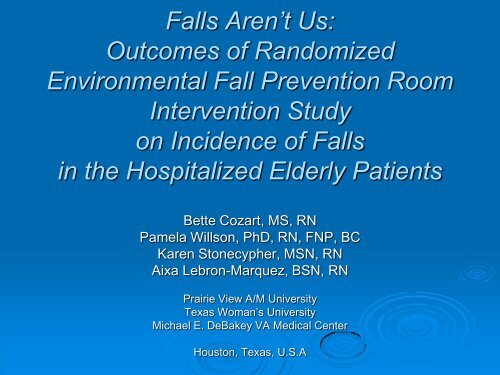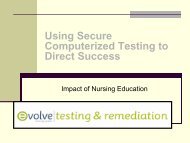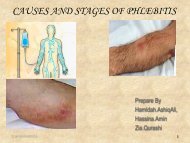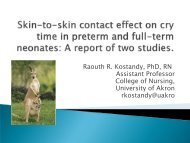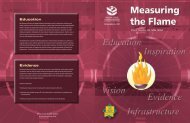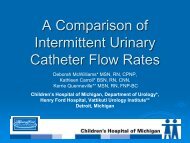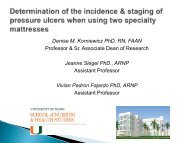Qualitative Research Proposal Exploring the Lived ... - IUPUI
Qualitative Research Proposal Exploring the Lived ... - IUPUI
Qualitative Research Proposal Exploring the Lived ... - IUPUI
Create successful ePaper yourself
Turn your PDF publications into a flip-book with our unique Google optimized e-Paper software.
Falls Aren’t Us:<br />
Outcomes of Randomized<br />
Environmental Fall Prevention Room<br />
Intervention Study<br />
on Incidence of Falls<br />
in <strong>the</strong> Hospitalized Elderly Patients<br />
Bette Cozart, MS, RN<br />
Pamela Willson, PhD, RN, FNP, BC<br />
Karen Stonecypher, MSN, RN<br />
Aixa Lebron-Marquez, BSN, RN<br />
Prairie View A/M University<br />
Texas Woman’s University<br />
Michael E. DeBakey VA Medical Center<br />
Houston, Texas, U.S.A
Funding<br />
‣ This study was funded by John Winston<br />
Carter <strong>Research</strong> and Dissertation Grants<br />
Texas Woman’s University<br />
College of Nursing<br />
Houston, Texas
Objectives<br />
‣ To describe Fall Prevention Rooms as an<br />
intervention that may reduce falls globally<br />
in <strong>the</strong> clinical settings.<br />
‣ To present outcomes of a fall prevention<br />
randomized clinical trial.
Falls<br />
• Nearly 10,000 elder Americans die<br />
annually from falls<br />
• (CDC, 2009)<br />
• Four to 12 falls occur in patients for<br />
every 1,000 days of hospitalization<br />
• (Kimbell, 2002)<br />
• Annually <strong>the</strong>re are 250,000 hip fractures<br />
costing an estimated $8 billion<br />
• (CDC, 2009)
<strong>Research</strong> Question<br />
‣ Do hospitalized patients, age 50 or older<br />
who score greater than 45 on <strong>the</strong> Morse<br />
Fall Scale report lower falls during a<br />
seven day hospital stay when assigned to<br />
a Fall Prevention Room than comparable<br />
hospitalized patients assigned to a<br />
Regular Room?
Definition<br />
‣Fall Prevention Rooms (FPR)<br />
‣ In-patient hospital rooms<br />
fitted with “fall prevention”<br />
environmental<br />
devices and equipment
Model of Fall Prevention Room<br />
Bed controls<br />
at fingertips<br />
Bed alarm<br />
Bedside<br />
commode<br />
placed alongside<br />
bed<br />
(replaces<br />
urinal)<br />
Non-skid<br />
floor<br />
Room<br />
illuminated<br />
at all times<br />
Bed trapeze<br />
Falls<br />
prevention<br />
poster<br />
Non-exit side<br />
rails up<br />
for support<br />
Exit side<br />
head rail up<br />
for support<br />
and foot rail<br />
down at all<br />
times.<br />
Movable<br />
hand rail<br />
(Hemi- walker)<br />
within reach<br />
Non-slip floor mat absorbs fluids, food, & stool, and prevents slips
‣ Safety Variables:<br />
• low position beds<br />
• bed alarms<br />
• beveled edged floor<br />
• Mats<br />
• shower mats<br />
• Hipsters<br />
• nonskid shower<br />
• Slippers<br />
• nonskid slippers<br />
• double-sided nonskid<br />
• Socks<br />
• grab rails<br />
FPR
Fall Definition<br />
“Loss of upright position that results in landing<br />
on <strong>the</strong> floor, ground or an object or furniture<br />
or as a sudden, uncontrolled, unintentional,<br />
non-purposeful, downward displacement of<br />
body to <strong>the</strong> floor or ground and/or hitting<br />
ano<strong>the</strong>r object like a chair or stair. This does<br />
NOT include patients assisted safely to a<br />
lower surface by ano<strong>the</strong>r individual.”<br />
Fall Prevention and Management Standard of Care, MEDVAMC
Morse Fall Scale<br />
‣ Six Items<br />
‣ Predictive validity & inter-rater reliability<br />
‣ Rapid & simple method<br />
•<br />
‣ Used widely in U.S. acute care settings
Morse Fall Scale<br />
‣ Reliability & Validity<br />
• 72 % sensitivity<br />
• 51 % specificity<br />
• 51 % accuracy<br />
• 38 % positive predictive value<br />
• 81 % negative predictive value<br />
• 30 % prevalence<br />
Morse, Morse, and Tylko (1989)
Morse Fall Scale<br />
Points Score<br />
1. History of falling No 0________ Yes 25________<br />
2. Secondary diagnosis No 0________ Yes 15________<br />
3. Ambulatory aid<br />
none/bedrest/nurse assist 0; crutches/cane/walker15; furniture30<br />
4. Intravenous <strong>the</strong>rapy/ heparin lock No 0____ Yes 20________<br />
5. Gait<br />
normal/bedrest/wheelchair0_weak 10_______impaired 2________<br />
6. Mental status<br />
oriented to own ability 0_ overestimates / forgets limitations 15________<br />
Morse, Morse & Tylko. (1989). Canadian Journal on Aging.
Environmental Theory:<br />
Neuman Systems Model<br />
‣ Hospitalization - external environmental stressor<br />
contributing to falls<br />
‣ Flexible line of defense - acts as protective<br />
buffer system for <strong>the</strong> patient’s normal or stable<br />
state<br />
‣ FPR - acts as a flexible line of defense<br />
environmental protective buffer for fall hazards<br />
protecting <strong>the</strong> normal line of defense<br />
Neuman & Fawcett (2002), p. 17
Design<br />
‣ Two-group prospective experimental<br />
design<br />
‣ Controlled block randomization<br />
• Groups of 16<br />
‣ Inclusion Criteria<br />
• In-patients age 50+<br />
• High risk for falling<br />
• > 45 points on Morse’s Scale<br />
• 7 day hospital stay
Sample<br />
n = 32<br />
Randomly assigned<br />
to FPRs<br />
N = 120<br />
Recruited<br />
N = 111<br />
Consented &<br />
Enrolled<br />
n = 32<br />
Randomly assigned to<br />
Regular Room<br />
n = 9<br />
declined<br />
n = 28<br />
n = 47<br />
Excluded<br />
< 7 days<br />
n = 19
Instruments<br />
‣ Screening<br />
• Morse Fall Scale<br />
• High-risk for fall = 45 points or higher<br />
‣ FPR<br />
• Equipment Safety Checklist<br />
‣ Falls<br />
• Participant Self-report<br />
• Hospital Fall Incident Report Forms
Demographics<br />
‣ Age<br />
• Participants Mean age was 64 years (SD = 8.94)<br />
‣ Gender<br />
• Most were age 50 – 65 years (62%)<br />
• A third were age 67 – 86 years (38%)<br />
• Ninety-seven percent were Men<br />
‣ Race<br />
• White 56% (n = 36)<br />
• African-Am 38% (n = 24)<br />
• Hispanic 6% (n = 4)
Clinical Findings<br />
‣ A total of 4 falls occurred during <strong>the</strong> study<br />
timeframe<br />
‣ (6.3 %, n = 64)<br />
• 3 falls occurred in Regular Rooms (RR)<br />
• (4.7%, n = 3)<br />
• 1 falls occurred in a Fall Prevention Room (FPR)<br />
• (1.6 %, n = 1)
In-Patient Hospital Day<br />
1<br />
0.9<br />
0.8<br />
0.7<br />
0.6<br />
0.5<br />
0.4<br />
0.3<br />
0.2<br />
0.1<br />
0<br />
Day 1 Day 2 Day 3 Day 4 Day 5 Day 6 Day 7<br />
Fall
Results<br />
‣ No statistically significant difference in <strong>the</strong><br />
number of falls for those patients assigned<br />
to FPRs vs RRs<br />
• Fischer’s Exact Probability Test<br />
• (One-tail; p < .05)<br />
• p = 0.306
Clinical Significance<br />
50% fewer falls occurred in <strong>the</strong> FPRs
Nursing Implications<br />
‣ The Joint Commission<br />
• Patient Safety Goal # 9<br />
• Reduce <strong>the</strong> risk of<br />
patient harm resulting<br />
from falls.<br />
‣ Healthy People 2010<br />
• Goal 15 is to reduce<br />
death from falls
Recommendations<br />
‣ Increase sample to all facility units<br />
‣ Different populations & settings<br />
‣ Different fall prevention equipments<br />
• Enclosure beds, etc.<br />
‣ <strong>Qualitative</strong> studies<br />
• Patient’s experiences, etc.<br />
‣ Economic costs<br />
• Structural Design
Acknowledgments<br />
‣ U.S. Military Veterans<br />
• Past & Present for <strong>the</strong>ir service to our country<br />
‣ Michael E. DeBakey VA Medical Center<br />
• All Nursing Staff & Allied Personnel<br />
‣ Baylor College of Medicine<br />
• Dr. Nancy Petersen, Statistician<br />
‣ POSEY Company<br />
• Ernie Posey, CEO & David Rohrer, Sales Manager


